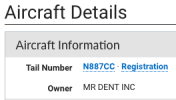Pattern work in a light twin is by far the most dangerous flight regime. I would absolutely NOT recommend doing pattern work in an aircraft that is being prepared to be ferried. Short hops? Sure, but being low on energy in a light twin is a bad idea. Let's go easy on the rampant **** flinging.
No need to throw such words out there, doesn't make it any more acceptable if use *****s instead.
A few laps in the pattern doesn't mean doing touch and go landings, with changing airspeeds and altitudes that put you in a low energy state. (Which, by the way, if you look closely at the ADS-B track, is what it appears they did before departing for PA).
Let me rephrase that for you - I saw no sign of a risk-mitigation post-maintenance flight, of a duration long enough to have a chance of uncovering any potential engine or airframe issues (bolts not fully torqued, loosening up after one hour but not after a lap or two in the pattern, and so on), at a safe altitude and close enough to the airfield that a safe return could be attempted in case a major malfunction developed, before deciding to embark on a 500-mile cross-country flight.
I've seen people spend an hour or two circling above the field, within gliding range, after engine work. That's my safety-minded expectation.
I have no doubt Sam was a great human being (I mean it). Sadly, none of us are infallible. I have seen other nice guys succumb to get-there-itis and expectation bias.
FYI, Vmc on a GA-7 is below stall speed.
That explains why it didn't look like a spin but more like a straight impact.

 channel3now.com
channel3now.com



